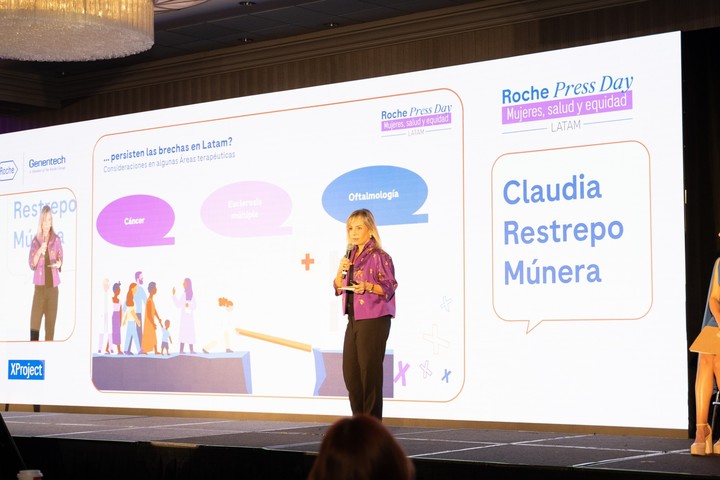

Women’s health should not imply a cost but an investment, and that investment should arouse in governments the same interest as any other token placed on a certain activity to obtain an economic return. This proposal, as striking as it may be, was one of the main topics discussed at the Roche Press Day, a meeting held this week in Miami, United States, and in which Clarion.
All the reasoning is based on a harsh reality that motivated the conference: the dramatic gender inequality in health, not only at a regional but global level, warned – each in their own way – the almost 40 exhibitors distributed in almost 15 panels held in two days.
However, when talking about inequality, we usually point to the edge – no less – of the consequences on the health of thousands of people and the burden that this implies on the systems. Much less explored or disseminated is the cold financial leg linked to this issue.
Claudia Restrepo, partner and regional director of the Deloitte Health Equity Institute, a panelist who spoke with Clarion.
Although several of her colleagues observed that the waste due to not addressing – with specific policies – women’s health issues reaches incalculable dimensions, some companies (such as the one that makes up Restrepo) are beginning to measure it. Maybe it’s not pure philanthropy. Or what company dedicated to health could benefit from the system going bankrupt?
 Claudia Restrepo Múnera during her conference at Roche Press Day.
Claudia Restrepo Múnera during her conference at Roche Press Day.“The numbers are beginning to show that we must react. Health systems are collapsing. There are greater costs for women and if certain conditions are not attended to, the entire situation will worsen,” she shared, alluding to the figures that she herself had presented on film during her talk.
Women: deteriorated health, deteriorated life
To get the idea straight, the “news”, if it can be called that, is that different actors related to health – such as pharmaceutical companies, too – are beginning to warn that, although science is advancing by leaps and bounds in its knowledge about pathologies, and conditions that affect women’s health, and although more and more innovative and precise drugs are being developed to address these diseases, due to ignorance or laziness the “decision makers” (governments and other health authorities) do not deploy prevention and approach policies chord.
On the contrary, the status quo: a medicine thought androcentrically; mounted on the “logical” male model.
At the meeting, the panelists made it clear that this phenomenon can be pursued in all areas. From what happens inside the offices to the fact that clinical studies for new drugs have little female participation. Without going any further, 2020 data from the McKenzie Institute of Health reveals that only 1% of global health research and innovation is invested in women-specific conditions.
But the concrete thing is that inattention translates into lost money. It is an amount that grows every day. Countries pay for it, given the greater burden of diseases (that is, they live putting out health fires that are avoidable or not so difficult to reduce).
But women also pay for it.
 For women, the out-of-pocket cost of health is 18 percent higher than that of men.
For women, the out-of-pocket cost of health is 18 percent higher than that of men.How much more does health cost women?
“They pay 18% more than men in annual out-of-pocket health expenses,” Restrepo reported in his conference. The figure does not include expenses related to maternity. If these expenses were added, the gap reaches 20%.
She was decisive and emphatic, like someone who knows that one thing is reporting finances and another is sensations, a term pejoratively associated with the feminine world. Surely Restrepo understands that everything can be “psychological”, if you want to dismiss the interlocutor. “Evidence” is needed, he stressed.
“You have to have reasons before statements. It’s easy to fall into the rhetoric that ‘we are all equal’, but where are the real opportunities? If you look at health, for many employers taking a woman of reproductive age can be a problem. One thinks that it is a super old view, but it still exists and the challenge is enormous.”
While “46% of men have close to US$1,000 or less in out-of-pocket expenses related to health, in women that figure grows by 35%.”
If you look at women between 19 and 64 years old and compare them to men of the same age, they always pay more. The figure does not include anything related to motherhood. And yet, “women pay an average of $266 extra per year.”
If one wants to delve into the cause of this expense, one must start by using the plural. It is a multifactorial phenomenon that spans from when women they get sicker from certain pathologies that involve expensive treatments to the neglect of their own health due to the care tasks to which they are subject. The famous double workload.
And it’s not just medical checkups that are postponed. They are also not adequately listened to by treating doctors, and then end up ignored or misdiagnosed, in part due to the dominant ignorance of the specificities of their body, which for too long was not the center of attention of doctors and scientists. It is a vicious circle fed by different interconnected phenomena.
In a study a couple of years ago, the World Economic Forum itself put it in these terms: diagnosing the same diseases in women It arrives four years later than to men. That has a cost. Restrepo said it is a “hidden cost.”
Young women in doctors offices
Another of the speakers, Valentina Sartori, an expert at the McKinsey Health Institute, completed the circle started by Restrepo and referred to a key fact in relation to the above, and that is that some of the most prevalent diseases in women tend to appear in their years of full employment.
In the different conferences, special focus was placed on three areas: ophthalmological problems, multiple sclerosis and cancer. We would have to add a set of diseases that are never associated with women, but are the main cause of death: heart disease.
When women of working age get sick, the economic losses (due to lack of human resources) become enormous, Sartori stressed, warning of the need to weigh the gain that would be generated by only stopping part of the problem.
Taking more of the gaps outlined by Restrepo, employer-sponsored health coverage in the United States “has an actuarial value of $1.34 billion less than for men of the same age (19-64).” But closing that gender gap would cost little, he noted: “Less than $12 per employee, per year.”
It should not draw attention, in a context in which salary compensation also has large gender differences, the expert recalled: “For every dollar a man earns, a woman receives US$0.82.”
Health policies focused on women
Is any of this of interest to the governments of Latin America? Are there conversations going on, at least? Restrepo was not optimistic: “Very short-term decisions are made and focused on a very general condition of women. Many measures are established, designed and implemented, but when the period of the current government ends, they are starts again from scratch”.
Thus, “you can’t know what worked and what didn’t, and everyone wants to leave their own mark,” even when “the same political color continues,” he analyzed. Looking at the “investment-return” equation, the problem is the lack of leaders who understand that “the return may be seen later, and not in their government period.”
Many of these problems would be solved with more women in decision-making positions, different panelists at this meeting warned. The gap, however, remains enormous, also in that sense.
Meanwhile, María Pía Orihuela, general manager of Roche Argentina, considered it key to start talking and analyzing these issues: “The first thing is to recognize that women’s health is important. Everyone’s is, but women’s has certain barriers that cause us to have very different results. Sociocultural and infrastructure barriers -in this country that is so vast-, among others. We must recognize that investing in health will bring you economic and social rewards.”
Once that is recognized, “you have to look at the women’s health indicators and understand them. Only then can you define where you want to go. That is, establishing goals that can generate a commitment and from there determining the measures to follow to meet those objectives.”
It is a step by step, with the intelligence of a good investor. The actors involved should be several: “It would have to be in public-private collaboration, since health is very complex. But not only with companies; also with the academy and the Legislative Branch. You have to set specific objectives. With that clear intentionality, the work will be unleashed and then there will be a path.”
